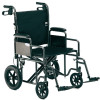Invacare TRHD22FR Owners Manual - Page 7
General Guidelines
 |
View all Invacare TRHD22FR manuals
Add to My Manuals
Save this manual to your list of manuals |
Page 7 highlights
SECTION 1-GENERAL GUIDELINES SECTION 1-GENERAL GUIDELINES ƽ WARNING SECTION 1 - GENERAL GUIDELINES contains important information for the safe operation and use of this product. Operating Information To determine and establish your particular safety limits, practice bending, reaching and transferring activities in several combinations in the presence of a qualified health professional before attempting active use of the transport chair. Make sure the back is locked securely before using this transport chair. ALWAYS check hand grips for looseness before using the transport chair. If loose and/or worn, replace immediately. If transport chair is exposed to extreme temperature (above 100°F or below 32°F), high humidity and/or becomes wet, prior to use, ensure handgrips DO NOT twist on the transport chair handle ‐ otherwise damage or injury may occur. DO NOT attempt to reach objects if you have to move forward in the seat. DO NOT attempt to reach objects if you have to pick them up from the floor by reaching down between your knees. DO NOT lean over the top of the back upholstery to reach objects behind you, as this may cause the transport chair to tip over. DO NOT shift your weight or sitting position toward the direction you are reaching as the transport chair may tip over. DO NOT tilt the transport chair without assistance. DO NOT use an escalator to move a transport chair between floors. Serious bodily injury may occur. NEVER leave an unoccupied transport chair on an incline. DO NOT attempt to stop a moving transport chair with wheel locks. Wheel locks are not brakes. Invacare recommends that a non‐folding device be installed to keep the transport chair from being folded when left unoccupied in a public place. Before attempting to transfer in or out of the transport chair, every precaution should be taken to reduce the gap distance. Turn both casters parallel to the object you are transferring onto. When transferring to and from the transport chair, ALWAYS engage both wheel locks. If the transport chair is equipped with hand brakes, ALWAYS lock both hand brakes before transferring to and from the transport chair. DO NOT sit or transfer into the transport chair unless it is fully open. DO NOT operate on roads, streets or highways. DO NOT climb, go up or down ramps or traverse slopes greater than 9 degrees. DO NOT attempt to move up or down an incline with a water, ice or oil film. DO NOT attempt to ride over curbs or obstacles. Doing so may cause your transport chair to tip over and cause bodily harm or damage to the transport chair. Invacare products are specifically designed and manufactured for use in conjunction with Invacare accessories. Accessories designed by other manufacturers have not been tested by Invacare and are not recommended for use with Invacare products. DO NOT overtighten hardware attaching to the frame. This could cause damage to the frame tubing. Part No.1125095 7 Transport Chairs















